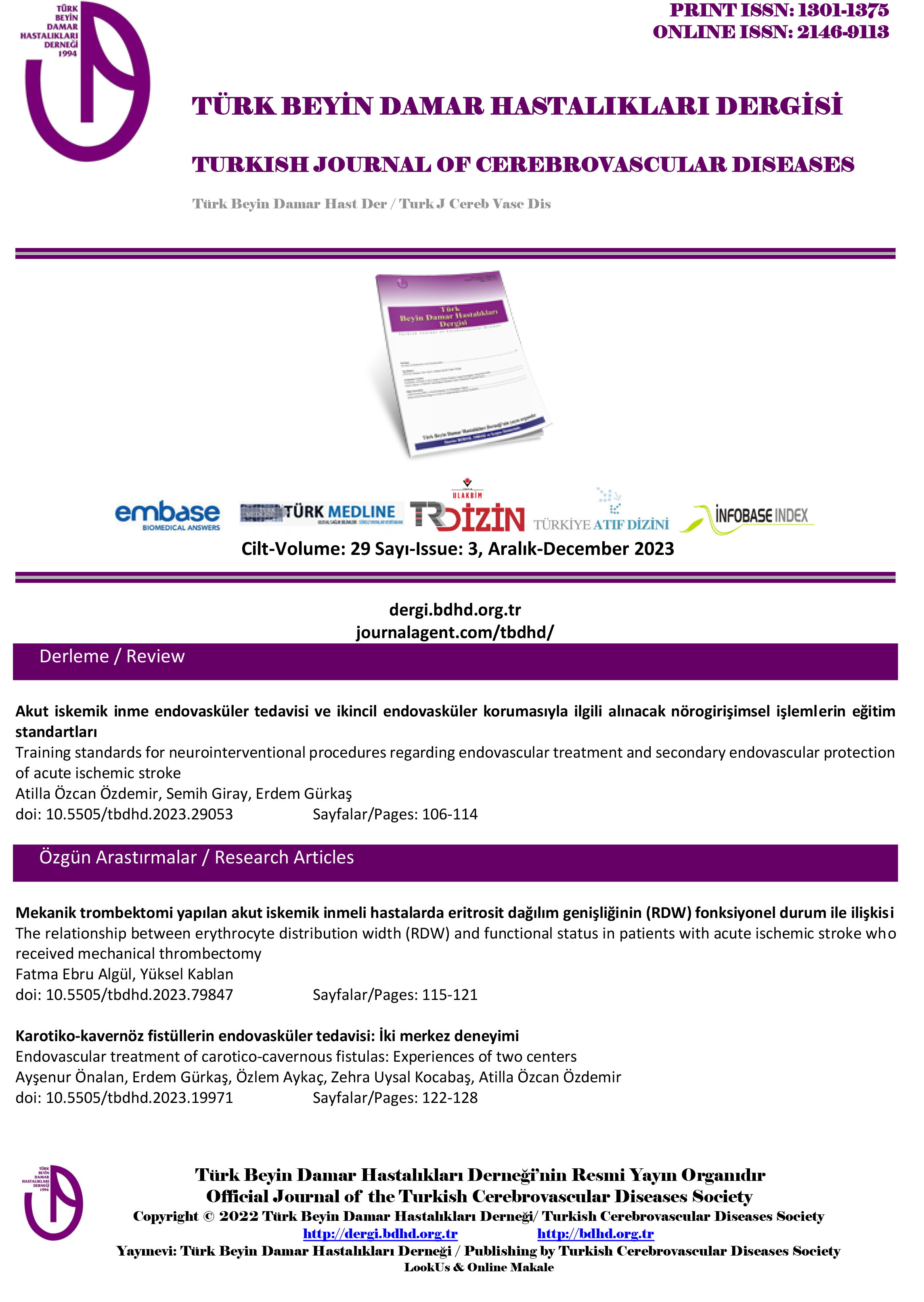Baziler arter oklüzyonu olan akut iskemik inme hastalarında intravenöz trombolitik tedavinin mekanik trombektomi sonuçları üzerine etkisi
Fergane Memmedova1, Zehra Uysal Kocabaş2, Özlem Aykaç2, Atilla Özcan Özdemir21Hatay Eğitim ve Araştırma Hastanesi, Nöroloji Yoğun Bakım Ünitesi, Hatay2Eskişehir Osmangazi Üniversitesi Tıp Fakültesi, Nöroloji Anabilim Dalı, Eskişehir
GİRİŞ ve AMAÇ: Çalışmanın amacı, mortalite riski yüksek olan akut baziler arter oklüzyonu olan inme hastalarında intravenöz trombolitik tedavinin mekanik trombektomi sonuçları üzerinde etkisini belirlemektir.
YÖNTEM ve GEREÇLER: 2018- 2022 tarihler arasında hastanemize başvuran, baziler arter oklüzyonu olan ve mekanik trombektomi işlemi uygulanan akut inme hastalarının verileri retrospektif olarak incelenerek çalışmaya dahil edildi. Hastaların demografik özellikleri, komorbiditeleri, başvuru sırasındaki NIH inme ölçeği, radyolojik görüntüleme sonuçları, semptom başlangıç zamanı, intravenöz doku plazminojen aktivatörü (IV-tPA) tedavisi ve kontrendikasyonları incelendi. Beyin bilgisayarlı tomografi (BT) ve BT anjiyografi sonuçları incelenerek pc-ASPECT (Posterior Circulation Alberta Stroke Program Early Computed Tomography Score) ve BATMAN (the Basilar Artery on Computed Tomography Angiography) skorları değerlendirildi. IV tPA ve endovasküler tedavi (EVT) uygulanan hasta grubu ile direkt EVT uygulanan hastaların sonuçları karşılaştırıldı. İki grubun işlem sonrası rekanalizasyon sonuçları, EVT komplikasyonları, taburculuk ve 3 ay sonrasındaki fonksiyonel sonuçları karşılaştırıldı. Klinik sonlanım, modifiye rankin skalası(mRS) kullanılarak belirlendi. mRS 0-2 olanlar iyi, mRS 3-6 olanlar ise kötü klinik sonlanım grubuna alındı.
BULGULAR: IV tPA artı EVT kombinasyonu uygulanan hasta grupu ile direct EVT uygulanan grubun sonuçları karşılaştırıldı. İşlem sonrası tam rekanalizasyon sağlanan hastaların oranı direct EVT grubunda %53.3 iken, kombine grupta %42.9 idi. EVT sonrası intrakranial kanama direkt EVT grubunda %13.3 iken, kombine grupunda %7.1 idi. EVT sonrası distal emboli toplam %27.1 oranında gözlemlendi. Bunlardan %22.2si direct EVT grubunda, %42.9u ise kombine grubunda idi. İki grup arasında istatiksel olarak anlamlı fark saptanmadı. EVT sonrası reoklüzyon direct EVT grubunda 3 (%56.7) hastada izlenirken, kombine grupta 2 (%14.3) hastada görüldü. MRS 0-2 direkt EVT grubunda % 31.1, kombine grupta ise %35.7 idi. MRS 3-6 direkt EVT grubunda %68.9 iken, kombine grupta %64.3 idi. Gruplar arasında istatiksel olarak anlamlı fark saptanmadı. Binary lojistik analizinde ileri yaş kötü sonlanım riskini 1.054 kat artırırdı. Tip 3 akus aortu olanların kötü sonlanım riski tip 1 olanlara göre 10.5 kat artırdı.
TARTIŞMA ve SONUÇ: Direk EVT ve IVtPA artı EVT kombinasyonu uygulanan hasta gruplarında tedavi şeklinin mRS üzerinde istatistiksel olarak anlamlı bir etkisi bulunmadı. İleri yaşın kötü klinik sonlanım üzerinde direkten etkisi görüldü.
Effect of intravenous thrombolytic therapy on mechanical thrombectomy outcomes in acute ischemic stroke patients with basilar artery occlusion
Fergane Memmedova1, Zehra Uysal Kocabaş2, Özlem Aykaç2, Atilla Özcan Özdemir21Hatay Training and Research Hospital, Neurointensive Care Unit, Hatay, Türkiye2Eskişehir Osmangazi University Faculty of Medicine, Department of Neurology, Eskişehir, Türkiye
INTRODUCTION: The aim of the study is to determine the effect of intravenous thrombolytic therapy on mechanical thrombectomy outcomes in stroke patients with basilar occlusion who have a high risk of mortality.
METHODS: The data of acute stroke patients who applied to our hospital between January 2018 and June 2022, who had basilar artery occlusion and underwent mechanical thrombectomy, were retrospectively analysed and included in the study. Patients' demographic characteristics, comorbidities, medications, blood pressure at admission to the emergency room, NIHSS, radiological imaging results, symptom onset time, intravenous recombinant tissue plasminogen activator (IV tPA) treatment and contraindications were examined. The posterior circulation Alberta stroke program early computed tomography score (pc-ASPECT) and the basilar artery on computed tomography angiography (BATMAN) scores were evaluated by examining brain computed tomography (CT) and CT angiography results. The results of the patients who received combined IV tPA and endovascular thrombectomy (EVT) were compared with the patients who underwent EVT alone. Post-procedure recanalization results, EVT complications, functional outcomes at discharge and 3-month outcomes were compared between the two groups. Clinical outcome was determined using the modified Rankin scale (mRS). Those with mRS 0-2 were included in the good clinical outcome group, whereas those with mRS 3-6 were included in the poor clinical outcome group.
RESULTS: The results of the patient group treated with combined IVtPA and EVT were compared with the group treated with EVT alone.The rate of patients who achieved complete recanalization after the procedure was 53.3% in the direct EVT group, compared to 42.9% in the combined group. Intracranial bleeding after EVT was13.3% in the direct EVT group,while it was7.1% in the combined group. After EVT, reocclusion was observed in 3(56.7%)patients in the direct EVT group and in2(14.3%) patients in the combined group. MRS was 31.1%in the0-2 direct EVT group and 35.7%in the combined group.While mRS3-6 was 68.9%in the directEVT group,it was 64.3%in the combined group.There was no statistically significant difference between the groups. Binary logistic analysis showed that advanced age increased the risk of poor outcome.Those with type3 aortic arch increased the risk of poor outcomes 10.5 times compared to those with type1.
DISCUSSION AND CONCLUSION: There was no statistically significant effect of the treatment type on mRS in the patient groups who received direct EVTand IVtPA plusEVT combination.Advanced age was found to be directly associated with poor clinical outcome.
Sorumlu Yazar: Fergane Memmedova, Türkiye
Makale Dili: İngilizce










